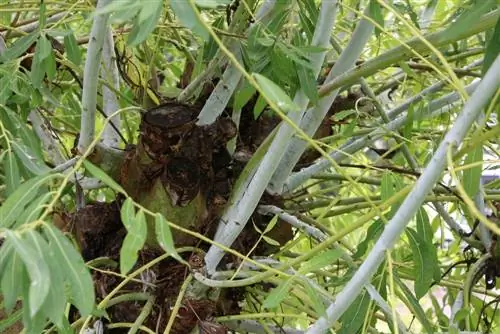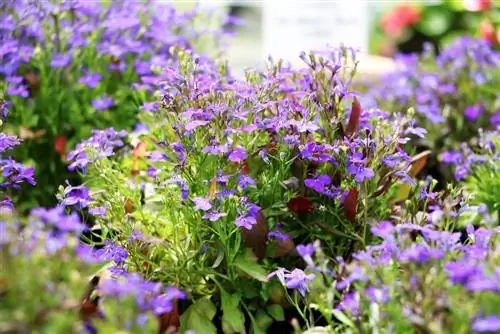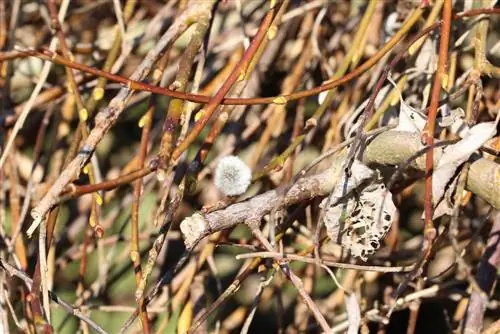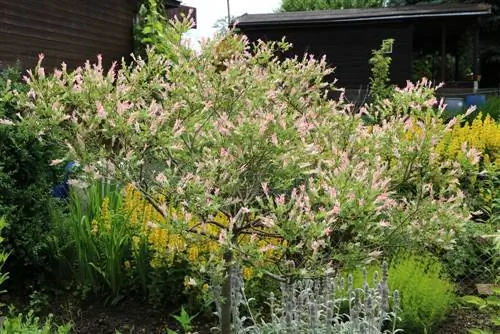- Author admin [email protected].
- Public 2023-12-17 03:39.
- Last modified 2025-01-24 12:45.
The weeping willow has a very romantic and unique look. If you have enough space in your garden, you should definitely plant this atmospheric plant. It looks particularly good in a pond where it is reflected.
Location
The weeping willow appreciates sunny and spacious locations where it can spread its lush shoots almost into a spherical treetop. The weeping willow looks particularly beautiful on water surfaces such as a garden pond. Here it can show its beauty perfectly through the reflection in the water and its growth towards the water. When choosing a location for the weeping willow, you should immediately take into account that the weeping willow is not one of the plants that can be moved anywhere. Because weeping willows can reach a height of up to 20 meters and take up a lot of space due to their hanging branches, you should make sure to find a suitable spot when planting that offers the plant plenty of sun and plenty of space in all directions.
An important factor when choosing a location is that older plants in particular have a great risk of breaking off due to the enormous weight of the hanging tree crown and possible fungal infestation, which makes moving an older plant practically impossible. If supporting equipment does not support the plant in its current location, it must be felled completely.
The ideal location
- is extensive because the plant grows enormously
- takes into account sufficient distance from other plants and parts of the building
- should be final as the pasture makes relocation difficult
Plants
Overall, the hanging willow is a robust and easy-care deciduous tree that is very suitable for large gardens due to its special growth pattern. Even if the weeping willow is often found near bodies of water, it does not necessarily have to be in direct proximity when planted. When planting the weeping willow, it is important to ensure there is sufficient distance from garden fences, garden sheds and residential buildings. In addition, the roots of the tree are so strong that they can easily damage underground pipes, pipes and even gas pipes. It is therefore important to ensure optimal safety when planting.
As is usual with all deciduous trees, the weeping willow is planted before the leaves emerge. This can happen between October and March. It is important that the planting hole for the weeping willow has three times the diameter and three times the depth of the root ball, as this makes it easier for the willow to take root. Enriching the soil with compost before planting and thorough watering immediately after planting make it easier for the willow to grow.
The fact that the plant takes up a lot of space should be taken into account when planting. Plants that are in the immediate vicinity of the weeping willow have a very difficult time thriving perfectly in the shade of the willow. It is therefore important to maintain a minimum distance of around seven to 10 meters from other trees or bushes. You should also avoid directly planting the open space under the pasture with small plants. If the willow sprouts heavily, its branches will ultimately reach down to the ground, depriving the plants below of the last bit of light.
Substrate & Soil

The weeping willow appreciates a humus-rich and moist subsoil. This is the reason why it is often found in nature on streams, ponds, lakes and rivers.
Fertilize
Universal or long-term fertilizer is rather unsuitable for the weeping willow. It is much better to mix sufficient compost into the already mulched soil of the young plant in spring and autumn. This is the best way to supply the tree with the necessary nutrients. It also makes sense not to remove the fallen leaves in autumn, but instead to spread them around the weeping willow as natural fertilizer. The microorganisms it contains ensure that the leaves decompose and thus enrich the soil with important nutrients.
Pouring
Hanging willows naturally have a high tolerance for waterlogging. That's why they don't necessarily need a permeable soil. Watering the plant does not have to be done in doses, but can be done generously. However, it is important that the root ball never dries out completely, especially in the hot summer months, because the willow quickly takes offense at a lack of water and shows this with yellow and prematurely falling leaves. Older plants with lush roots are able to obtain water from the soil as long as it rains regularly, even in the hot summer months. However, young trees still need support and should therefore be watered sufficiently several times a week.
Cutting
The weeping willow is undemanding overall - and that also applies to the cut. It is a deciduous tree that tolerates pruning and can easily forgive even major beginner mistakes. If a vigorous tree receives a radical pruning, it will thank you for it the next year with strong budding. If you want to enjoy the pussy willows in spring, you can postpone cutting until immediately after flowering. Because the willow has many strong branches, the hanging branches can quickly weigh several tons. That's why it makes sense to cut from the outside in and cut away the lower shoots. Only then can the main branches be cut. The closure of the wound edges can be accelerated by smoothing them with a chainsaw. The willow does not need any special tree wound ointment after cutting.
The intensive growth of the weeping willow makes it very time-consuming to correct the growth height of the weeping willow by cutting. If a radical cut is desired, it can be done using topiary pruning, whereby the hanging shoots are brought into the desired direction of growth. To do this, the branches are cut back by 2/3 of their length. It is important that the cut is made below pairs of leaves or buds that have the desired direction of growth. Transverse shoots can then also be removed within the cut.
Wintering
In its first winter outdoors, the weeping willow still needs support against the cold. The root system should then be protected with a layer of horn shavings or humus. If the tree is properly rooted, the weeping willow no longer needs frost protection. However, thin trunks of young plants should be protected from autumn storms or tipping over using medium-strong stakes.
Diseases/Pests
The weeping willow is not very susceptible to diseases and pests. However, some fungal pathogens can cause problems. However, chemical agents do not always have to be used to combat them, as the diseases can often be contained using simple means. Shoot tip drought, botanically referred to as Marssonina saliciola, shows itself in black-brown growths on the shoots of the willow. The fungus spends the winter within diseased parts of the pasture as well as in dead leaves on the ground. It then infects the pasture in the spring, producing leaf damage and injuries similar to hail damage. Control measures must now begin immediately to save the plant. Saving the weeping willow from shoot tip drought requires:
- Immediate, generous removal and destruction of affected plant parts
- Collect fallen leaves to prevent further spread
- If necessary, even use fungicides from specialist retailers
Another disease that can affect willow is willow scab. Especially on cold, wet days, there is often thickening of the branches and discoloration of shoots and leaves. These symptoms indicate the fungal pathogen called Pollaccia saliciperda. The discoloration spreads within a few days and a scab-like color ultimately leads to the death of affected leaves and shoot tips.
Helps against Pollaccia saliciperda:
- supplying the plant with phosphorus and potassium
- the immediate removal of infected leaves and branches
Galena particularly affects young plants and appears in the form of a white and lead-like shine on leaves and shoots, which then die. The culprit here is a fungus called Stereum purpureum, which enters the willow through cuts. Treating this pathogen is difficult. Possible measures against galena are:
- consistent pruning of the affected tree parts
- Promoting the tree's defenses using Salix as well as additional phosphorus and potassium.
Frequently asked questions
Can I propagate weeping willows myself?
The weeping willow can be easily propagated because it forms new roots when cuttings are placed in a container with water or directly in potting soil. Autumn is the most favorable time for propagation. Here a branch of the willow is cut off to a length of approx. 10 cm directly below one eye of the plant. The cutting is placed in water and all lower leaves are removed beforehand to prevent rot. Now roots will soon take place and the cutting can be moved to a pot with potting soil until it is strong enough for the garden.
Are weeping willows poisonous?
No, children and animals are not endangered by the weeping willow in your own garden. It only contains a substance similar to aspririn in extremely small quantities.
What you should know about the weeping willow soon
Location
- A weeping willow grows up to 20 meters high and develops a crown diameter of up to ten meters.
- It grows very quickly, especially when young, but even at the age of more than 20, the annual growth is more than 1/2 meter.
- Such a tree is therefore only suitable for locations where there is a lot of space available.
- In the wild, the weeping willow often grows near bodies of water, where it feels particularly comfortable, but it can also be planted in a dry location.
- In the garden, this tree needs a sunny to semi-shady place, but it is quite undemanding when it comes to soil conditions.
- However, its roots can be a bit problematic, as they can even penetrate water pipes under certain circumstances.
- When planting, you should therefore ensure that there is a sufficiently large distance from the house and other facilities in the garden.
Plants
- When planting a weeping willow, make sure that the planting hole is dug generously so that the new tree can root easily.
- It is placed in the ground at exactly the same height as it was before in the tree nursery.
- The best time to plant a weeping willow is autumn until the onset of frost, then the supply in the tree nurseries is greatest.
Care and cut
- The weeping willow can be cut back if necessary and then sprouts again without any problems.
- Even severe pruning doesn't affect this tree. In the past, the willow branches were cut regularly. They were used as braiding material.
- A weeping willow is absolutely frost hardy, but the ground around the trunk should still be covered in the first winter after planting.
Propagate
- Cuttings of this tree easily form new roots when placed in water or potting soil.
- The best time to propagate a weeping willow is autumn. Then a branch about 10 cm long is cut from the tree directly below one eye.
- The lower leaves are removed and the cutting is then placed in a glass of water. This will soon form roots.
- Then it can first be planted in a pot with potting soil until it has become strong enough to plant out in the garden.






